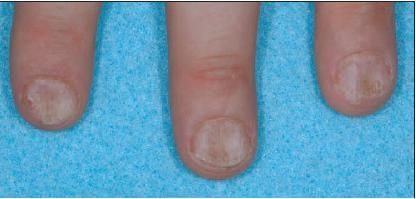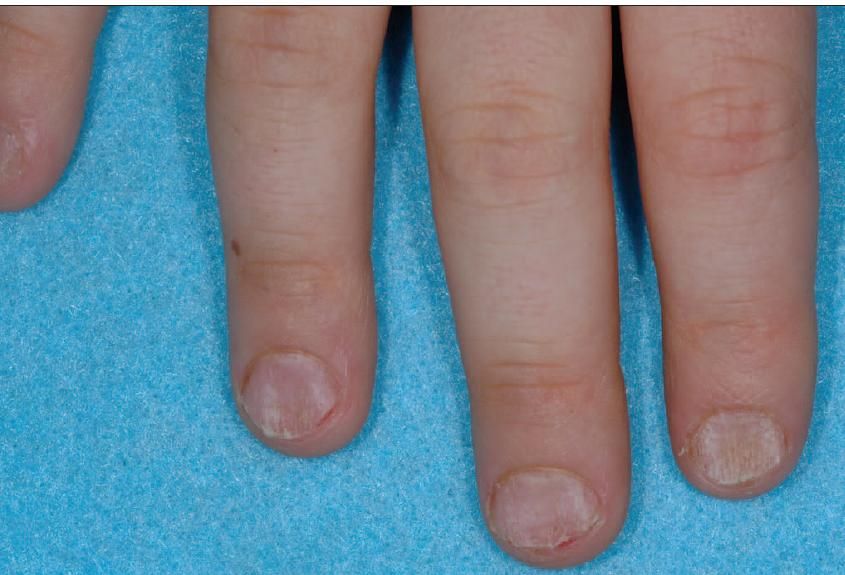Trachyonychia (Twenty-Nail Dystrophy)
I believe that there is an entity termed "twenty-nail dystrophy" that is a benign and idiopathic disorder. The nail plates have a distinct appearance and all 20 nails are dystrophic. The nail plates are lusterless and their surface appears to have been sandpapered in a longitudinal direction. The plates are thin and rough with accentuated longitudinal ridges and the cuticles appear to be "roughed up" and thickened. The free ends of the plates are brittle and rough. The nail plates do not appear to be growing.

Figure

Figure
Case:
The mother of this school-aged girl is concerned that her child has a fungal infection in her fingernails and that the nails are destroyed forever. Your examination reveals that all 20 of her nail plates are affected similarly.
Is the mother correct?
Case: Trachyonychia (Twenty-Nail Dystrophy)
This child has
twenty-nail dystrophy
-the name given to an acquired condition of the nails that often occurs as an isolated event. The more common term used currently for this condition is trachyonychia because the condition may not affect all 20 nails and similar morphological changes in the nail plate have been reported in association with alopecia areata, lichen planus, and psoriasis. The nail plate changes associated with these inflammatory conditions may precede the cutaneous findings by many months, which makes their diagnosis challenging.
I believe that there is an entity termed "twenty-nail dystrophy" that is a benign and idiopathic disorder. The nail plates have a distinct appearance and all 20 nails are dystrophic. The nail plates are lusterless and their surface appears to have been sandpapered in a longitudinal direction. The plates are thin and rough with accentuated longitudinal ridges and the cuticles appear to be "roughed up" and thickened. The free ends of the plates are brittle and rough. The nail plates do not appear to be growing.
The major parental concerns are for the long-term future of the nails and the possibility of a fungal infection.
If the presentation is typical, I am able to reassure the parents that this is not a fungal infection of the nail plates. However, I often find it necessary to do a fungal culture to support my opinion against all of the medical and non-medical advice that they have received to the contrary. The use of topical corticosteroids under occlusion has been advocated by some, but I have not found this approach to be successful. For that reason, and because parents tend to over-treat with topical steroids to this area, I am inclined to wait for the spontaneous resolution that almost always occurs over months to years in this childhood variant. I recommend only attention to the manicuring of the plates to avoid "catching" and the use of nail polish for cover if parents wish.
I advise parents that I believe the condition to be idiopathic, that the nail plates will return to normal as mysteriously as they have changed, that there will not be any scarring, and that nail polish will go on smoothly for their daughter's wedding.
Recognize & Refer: Hemangiomas in pediatrics
July 17th 2019Contemporary Pediatrics sits down exclusively with Sheila Fallon Friedlander, MD, a professor dermatology and pediatrics, to discuss the one key condition for which she believes community pediatricians should be especially aware-hemangiomas.